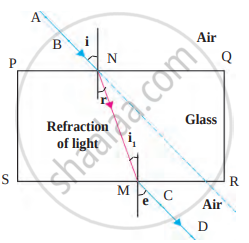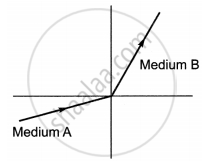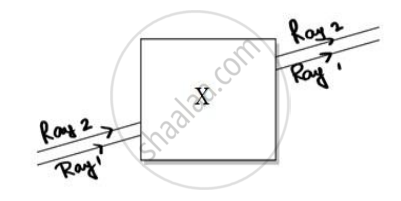Advertisements
Advertisements
प्रश्न
Prove the statement.
If the angle of incidence and angle of emergence of a light ray falling on a glass slab are i and e respectively, prove that, i = e.
उत्तर १

Let \[\mu\] be the refractive index of the glass slab. Then, according to Snell's law,
\[\frac{\sin i}{\sin r_1} = \mu\] .....(i)
Putting (iii) in (i), we have
Multiplying (i) and (iv), we have
or
\[i = e\]
उत्तर २
Light is travelling from air to glass.

where,
i = Angle of incidence
r = Angle of refraction
e = Angle of emergency
∴ gna = `1/(""_"a""n"_"g")` .....(i)
At surface PQ
gna = `(sin "i")/(sin "r")` .....(ii)
At surface SR
ang = `(sin "r")/(sin "e")` ....(iii)
Substituting (ii) and (iii) in (i)
`(sin "i")/(sin "r") = 1/((sin "r")/(sin "e"))`
∴ `(sin "i")/(sin "r") = (sin "e")/(sin "r")`
∴ sin i = sin e
∴ i = e
संबंधित प्रश्न
How refraction of light is related to refractive index?
The refractive indices of glass and water with respect to air are 3/2 and 4/3 respectively. If speed of light in glass is 2 x 108 m/s, find the speed of light in water.
The absolute refractive indices of two media 'A' and 'B' are 2.0 and 1.5 respectively. If the speed of light in medium 'B' is 2 × 108 m/s, calculate the speed of light in:
(i) vacuum,
(ii) medium 'A'.
A ray of light travelling in air enters obliquely into water. Does the light ray bend towards the normal or away from the normal? Why?
You are given kerosene, turpentine and water. In which of these does the light travel fastest? Use the information given in Table.
| Material medium |
Refractive index | Material medium | Refractive index |
| Air | 1.0003 | Canada Balsam | 1.53 |
| Ice | 1.31 | – | – |
| Water | 1.33 | Rock salt | 1.54 |
| Alcohol | 1.36 | – | – |
| Kerosene | 1.44 | Carbon disulphide | 1.63 |
| Fused quartz |
1.46 | Dense flint glass |
1.65 |
| Turpentine oil | 1.47 | Ruby | 1.71 |
| Benzene | 1.50 | Sapphire | 1.77 |
| Crown glass |
1.52 | Diamond | 2.42 |
The speed of light in air is:
(a) 3 × 108 cm/s
(b) 3 × 108 mm/s
(c) 3 × 108 km/s
(d) 3 × 108 m/s
A ray of light travelling in water falls at right angles to the boundary of a parallel-sided glass block. The ray of light:
(a) is refracted towards the normal
(b) is refracted away from the normal
(c) does not get refracted
(d) is reflected along the same path
What name is given to the ratio of sine of angle of incidence to the sine of angle of refraction?
The refractive index of diamond is 2.42. What is the meaning of this statement in relation to the speed of light?
The speed of light in vacuum and in two different glasses is given in the table below:
| Medium | Speed of light |
| Vacuum | 3.00 × 108 m/s |
| Flint glass | 1.86 × 108 m/s |
| Crown glass | 1.97 × 108 m/s |
(a) Calculate the absolute refractive indexes of flint glass and crown glass.
(b) Calculate the relative refractive index for light going from crown glass to flint glass.
The speed of light in air is 3 × 108 m/s. In medium X its speed is 2 × 108 m/s and in medium Y the speed of light is 2.5 × 108 m/s Calculate:
(a) air nx
(b) air nY
(c) x nY
What is the speed of light in a medium of refractive index `6/5` if its speed in air is 3,00,000 km/s?
The speed of light in water is 2.25 × 108 m/s. If the speed of light in vacuum be 3 × 108 m/s, calculate the refractive index of water.
The refractive indices of four substance P, Q, R and S are 1.50, 1.36, 1.77 and 1.31 respectively. The speed of light is the maximum in the substance:
(a) P
(b) Q
(c) R
(d) S
The speed of light in substance X is 1.25 × 108 m/s and that in air is 3 × 108 m/s. The refractive index of this substance will be:
(a) 2.4
(b) 0.4
(c) 4.2
(d) 3.75
The refractive index of water is:
(a) 1.33
(b) 1.50
(c) 2.42
(d) 1.36
The refractive index of water with respect to air is `4/3`. The refractive index of air with respect to water will be:
(a) 1.75
(b) 0.50
(c) 0.75
(d) 0.25
Refractive indices of water, sulphuric acid, glass and carbon disulphide are 1.33, 1.43, 1.53 and 1.63 respectively. the light travels slowest in:
(a) sulphuric acid
(b) glass
(c) water
(d) carbon disulphide
The following table gives the refractive indices of a few media:
| 1 | 2 | 3 | 4 | 5 | |
| Medium | Water | Crown glass | Rock salt | Ruby | Diamond |
| Refractive index | 1.33 | 1.52 | 1.54 | 1.71 | 2.42 |
Use this table to give an example of:
(i) a medium pair so that light speeds up when it goes from one of these medium to another.
(ii) a medium pair so that light slows down when it goes from one of these medium to another.
Refractive indices of four media A, B, C and D are given below:
| Medium | Refractive index |
| A | 1.33 |
| B | 1.44 |
| C | 1.52 |
| D | 1.65 |
In which of these four media is the speed of light (i) maximum, and (ii) minimum?
Name a liquid whose mass density is less than that of water but it is optically denser than water.
Mark the correct answer in the question.
If the refractive index of glass with respect to air is 3/2, what is the refractive index of air with respect to glass?
If in a medium, the speed of light is 1.5 × 108 m/s how much will the absolute refractive index of that medium be?
Solve the example.
If the absolute refractive indices of glass and water are 3/2 and 4/3 respectively, what is the refractive index of glass with respect to water?
The velocity of light in a medium is 1.5 x 188 m/s. What is the refractive index of the medium with respect to air, if the velocity in the air is 3 x 108 m/s?
_______ is the unit of refractive index.
2n1 : Refractive index of medium 2 with respect to medium 1 : : 1n2 : _______
Purple has the lowest refractive index.
A light ray enters from medium A to medium B as shown in figure. The refractive index of medium B relative to A will be ______.

Noor, a young student, was trying to demonstrate some properties of light in her Science project work. She kept ‘X’ inside the box (as shown in the figure) and with the help of a laser pointer made light rays pass through the holes on one side of the box. She had a small butter-paper screen to see the spots of light being cast as they emerged.

If the object inside the box was made of a material with a refractive index less than 1.5 then the ______.
Match the Columns:
| Column ‘A’ | Column ‘B’ |
| Refractive index of water | (a) 1.31 |
| (b) 1.36 | |
| (c) 1.33 |
How is the refractive index of material related to the velocity of light?
The refractive index of glass with respect to air is `5/4` and the refractive index of water with respect to air is `4/3`. Then what will be the refractive index of glass with respect to water?
| The ability of medium to refract light is expressed in terms of its optical density. Optical density has a definite connotation. It is not the same as mass density. On comparing two media, the one with the large refractive index is optically denser medium than the other. The other medium with a lower refractive index is optically rarer. Also the speed of light through a given medium is inversely proportional to its optical density. |
- Determine the speed of light in diamond if the refractive index of diamond with respect to vacuum is 2.42. Speed of light in vacuum is 3 × 108 m/s.
- Refractive indices of glass, water and carbon disulphide are 1.5, 1.33 and 1.62 respectively. If a ray of light is incident in these media at the same angle (say θ), then write the increasing order of the angle of refraction in these media.
- (A) The speed of light in glass is 2 × 108 m/s and is water is 2.25 × 108 m/s.
(a) Which one of the two optically denser and why?
(b) A ray of light is incident normally at the water glass interface when it enters a thick glass container filled with water. What will happen to the path of the ray after entering the glass? Give reason.
OR
(B) The absolute refractive indices of glass and water are 4/3 and 3/2, respectively. If the speed of light in glass is 2 × 108 m/s, calculate the speed of light in (i) vacuum (ii) water.
- Explain why the refractive index of any material with respect to air is always greater 1.
- In the figure below a light ray travels from air into the semi-circular plastic block. Give a reason why the ray does not deviate at the semi-circular boundary of the plastic block.

- Complete the ray diagram of the above scenario when the light ray comes out of the plastic block from the top flat end.
